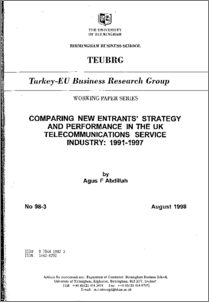Group by: No Grouping | No Grouping
Number of items: 1.
Comparing new entrants' strategy and performance in the UK telecommunications service industry: 1991-1997 The relationship between entry strategy and performance has been widely studied. Most of these studies were conducted or modelled in the context of free-competition industries. Little research has been conducted to study new entrant strategies in industries which were formerly natural monopolies ind... [ more ] The relationship between entry strategy and performance has been widely studied. Most of these studies were conducted or modelled in the context of free-competition industries. Little research has been conducted to study new entrant strategies in industries which were formerly natural monopolies industries. For this reason, this study is intended to compare and examine the relationship between new entrants strategy and performance in the newly liberalised industries, particularly in the UK telecommunications service during the period 1991-1997. The study found that entry into newly liberalised industry has not automatically resulted in the success of new entrants. In particular, the study has shown that all new entrants' losses were severe in the first three years of entry. AJI new entrants had a negative ROI, ROS, RONA, and Cash Flow. The new entrants also had a very small market share. Nevertheless, a half of the sample performed relatively better than another half of sample. Among the better performers, three were an entry by diversifying companies (Cable-TV Companies) and one was an entry by a newly created company. A diversifying company has benefited from its ability to capitalise existing customer base, skills and resources, and achieve economies of scale in network investment, operation and maintenance, and advertising and marketing. A newly createdinnovative entrant has benefited from its proprietary of technological (i.e. fixed radio access) advantage to avoid a high level of sunk cost, less investment per new subscriber, and faster network deployment. A better performer has also achieved a greater strategic flexibility as result of lower invested slack resources (i.e. capital expenditure, working capital, and marketing and administration costs) and higher generated slack resources (i.e. cash flow and ratio of current asset/current liabilities). The results of the study support the thought that type of entrants, magnitude of investments - generated slack and invested slack resources-, and competitive positioning are likely to have a significant relationship with the performance of new entrants, while timing of entry is only considered to be a contingent determinant of entry success. The results also suggest that pioneering advantage and competitive reaction to entry of the incumbents still became potential barriers to entry. | | ![[img]](/3262/1.hassmallThumbnailVersion/Abdillah_Comparing_new_entrants_Turkey%2DEU_Business_Research_Group_1998.pdf)  Preview |
|
|
This list was generated on Mon Mar 17 01:43:37 2025 GMT.

